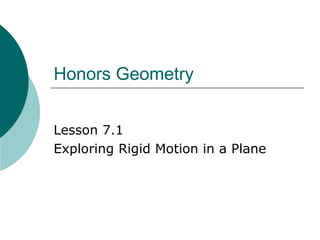
7.1 exploring rigid motion in a plane
- 1. Honors Geometry Lesson 7.1 Exploring Rigid Motion in a Plane
- 2. What You Should Learn Why You Should Learn It Goal 1: How to identify the three basic rigid transformations in a plane Goal 2: How to use transformations to identify patterns and their properties in real life You can use transformations to create visual patterns, such as stencil patterns for the border of a wall
- 3. Identifying Transformations Figures in a plane can be reflected, rotated, or slid to produce new figures. The new figure is the image, and the original figure is the preimage The operation that maps (or moves) the preimage onto the image is called a transformation
- 4. 3 Basic Transformations Reflection (flip) Translation (slide) Rotation (turn) Blue: preimage Pink: image http://standards.nctm.org/document/eexamples/chap6/6.4/index.htm
- 5. Example 1 Identifying Transformations Identify the transformation shown at the left.
- 6. Example 1 Identifying Transformations Translation To obtain ΔA’B’C’, each point of ΔABC was slid 2 units to the right and 3 units up.
- 7. Rigid Transformations A transformation is rigid if every image is congruent to its preimage This is an example of a rigid transformation b/c the pink and blue triangles are congruent
- 8. Example 2 Identifying Rigid Transformations Which of the following transformations appear to be rigid?
- 9. Example 2 Identifying Rigid Transformations Which of the following transformations appear to be rigid? The image is not congruent to the preimage, it is smaller The image is not congruent to the preimage, it is fatter
- 10. Definition of Isometry A rigid transformation is called an isometry A transformation in the plane is an isometry if it preserves lengths. (That is, every segment is congruent to its image) It can be proved that isometries not only preserve lengths, they also preserves angle measures, parallel lines, and betweenness of points
- 11. Example 3 Preserving Distance and Angle Measure In the figure at the left, ΔPQR is mapped onto ΔXYZ. The mapping is a rotation. Find the length of XY and the measure of Z
- 12. Example 3 Preserving Distance and Angle Measure In the figure at the left, ΔPQR is mapped onto ΔXYZ. The mapping is a rotation. Find the length of XY and the measure of Z B/C a rotation is an isometry, the two triangles are congruent, so XY=PQ=3 and m Z=m R =35° Note that the statement “ΔPQR is mapped onto ΔXYZ” implies the correspondence PX, QY, and RZ
- 13. Example 4 Using Transformations in Real-Life Stenciling a Room You are using the stencil pattern shown below to create a border in a room. How are the ducks labeled, B, C, D, E, and F related to Duck A? How many times would you use the stencil on a wall that is 11 feet, 2 inches long?
- 14. Example 4 Using Transformations in Real-Life Stenciling a Room You are using the stencil pattern shown below to create a border in a room. How are the ducks labeled, B, C, D, E, and F related to Duck A? How many times would you use the stencil on a wall that is 11 feet, 2 inches long? Duck C and E are translations of Duck A
- 15. Example 4 Using Transformations in Real-Life Stenciling a Room You are using the stencil pattern shown below to create a border in a room. How are the ducks labeled, B, C, D, E, and F related to Duck A? How many times would you use the stencil on a wall that is 11 feet, 2 inches long? Ducks B,D and F are reflections of Duck A
- 16. Example 4 Using Transformations in Real-Life Stenciling a Room You are using the stencil pattern shown below to create a border in a room. How are the ducks labeled, B, C, D, E, and F related to Duck A? How many times would you use the stencil on a wall that is 11 feet, 2 inches long? 11’2” = 11 x 12 + 2 = 134 inches 134 ÷ 10 = 13.4, the maximum # of times you can use the stencil pattern (without overlapping) is 13
- 17. Example 4 Using Transformations in Real-Life Stenciling a Room You are using the stencil pattern shown below to create a border in a room. How are the ducks labeled, B, C, D, E, and F related to Duck A? How many times would you use the stencil on a wall that is 11 feet, 2 inches long? If you want to spread the patterns out more, you can use the stencil only 11 times. The patterns then use 110 inches of space. The remaining 24 inches allow the patterns to be 2 inches part, with 2 inches on each end